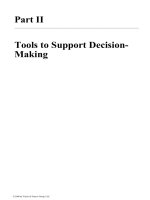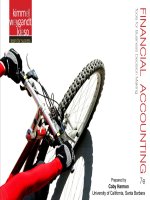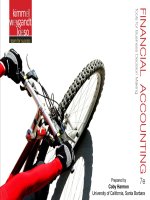Financial accounting 8e tool for busniess decision making chapter 09
Bạn đang xem bản rút gọn của tài liệu. Xem và tải ngay bản đầy đủ của tài liệu tại đây (1.9 MB, 79 trang )
9-1
9
Reporting and Analyzing
Long-Lived Assets
9-2
Kimmel ● Weygandt ● Kieso
Financial Accounting, Eighth Edition
CHAPTER OUTLINE
LEARNING OBJECTIVES
9-3
1
Explain the accounting for plant asset expenditures.
2
Apply depreciation methods to plant assets.
3
Explain how to account for the disposal of plant
assets.
4
Identify the basic issues related to reporting intangible
assets.
5
Discuss how long-lived assets are reported and
analyzed.
1
LEARNING
OBJECTIVE
Explain the accounting for plant asset
expenditures.
Plant assets are resources that have
physical
substance (a definite size and shape),
are
used in the operations of a business,
are
not intended for sale to customers,
are
expected to provide service to the company for a
number of years, except for land.
Referred to as property, plant, and equipment;
plant and equipment; and fixed assets.
9-4
LO 1
PLANT ASSETS
Plant assets are critical to a company’s success.
ILLUSTRATION 9-1
Percentages of plant assets in relation to total assets
9-5
LO 1
THE COST OF PLANT ASSETS
Historical Cost Principle
Requires that companies record plant assets at cost.
Cost consists of all expenditures necessary to acquire
an asset and make it ready for its intended use.
Revenue expenditure – costs incurred to acquire a plant
asset that are expensed immediately.
Capital expenditures - costs included in a plant asset
account.
9-6
LO 1
THE COST OF PLANT ASSETS
Cost is measured by the cash paid in a cash transaction or
the cash equivalent price paid.
Cash equivalent price is the
fair
value of the asset given up or
fair
value of the asset received,
whichever is more clearly determinable.
INTERNATIONAL NOTE
IFRS is flexible regarding asset valuation. Companies revalue to fair
value when they believe this information is more relevant.
9-7
LO 1
THE COST OF PLANT ASSETS
Land
All necessary costs incurred in making land ready for its
intended use increase (debit) the Land account.
Costs typically include:
1) cash purchase price,
2) closing costs such as title and attorney’s fees,
3) real estate brokers’ commissions, and
4) accrued property taxes and other liens on the land
assumed by the purchaser.
9-8
LO 1
THE COST OF PLANT ASSETS
Illustration: Assume that Hayes Manufacturing Company
acquires real estate at a cash cost of $100,000. The property
contains an old warehouse that is razed at a net cost of $6,000
($7,500 in costs less $1,500 proceeds from salvaged
materials). Additional expenditures are the attorney’s fee,
$1,000, and the real estate broker’s commission, $8,000.
Required: Determine the amount to be reported as the cost of
the land.
9-9
LO 1
THE COST OF PLANT ASSETS
Required: Determine amount to be reported as the cost of
the land.
Land
Cash price of property ($100,000)
$100,000
Net removal cost of warehouse ($6,000)
6,000
Attorney's fees ($1,000)
1,000
Real estate broker’s commission ($8,000)
8,000
Cost of Land
$115,000
ILLUSTRATION 9-2
Computation of cost of land
9-10
LO 1
THE COST OF PLANT ASSETS
Land Improvements
Includes all expenditures necessary to make the
improvements ready for their intended use.
Examples:
driveways, parking lots, fences,
landscaping, and underground sprinklers.
Limited
useful lives.
Expense
(depreciate) the cost of land improvements
over their useful lives.
9-11
LO 1
THE COST OF PLANT ASSETS
Buildings
Includes all costs related directly to purchase or
construction.
Purchase costs:
Purchase
price, closing costs (attorney’s fees, title
insurance, etc.) and real estate broker’s commission.
Remodeling
and replacing or repairing the roof, floors,
electrical wiring, and plumbing.
Construction costs:
Contract
price plus payments for architects’ fees, building
permits, and excavation costs.
9-12
LO 1
THE COST OF PLANT ASSETS
Equipment
Include all costs incurred in acquiring the equipment and
preparing it for use.
Costs typically include:
Cash
purchase price.
Sales
taxes.
Freight
charges.
Insurance
during transit paid by the purchaser.
Expenditures
required in assembling, installing, and
testing the unit.
9-13
LO 1
THE COST OF PLANT ASSETS
Illustration: Lenard Company purchases a delivery truck at a
cash price of $22,000. Related expenditures are sales taxes
$1,320, painting and lettering $500, motor vehicle license $80,
and a three-year accident insurance policy $1,600. Compute
the cost of the delivery truck.
Truck
Cash price
Sales taxes
Painting and lettering
Cost of Delivery Truck
9-14
ILLUSTRATION 9-3
$22,000
1,320
500
$23,820
LO 1
THE COST OF PLANT ASSETS
Illustration: Lenard Company purchases a delivery truck at a
cash price of $22,000. Related expenditures are sales taxes
$1,320, painting and lettering $500, motor vehicle license $80,
and a three-year accident insurance policy $1,600. Prepare the
journal entry to record these costs.
Equipment
23,820
License Expense
80
Prepaid Insurance
1,600
Cash
25,500
9-15
LO 1
EXPENDITURE DURING USEFUL LIFE
Ordinary Repairs are expenditures to maintain the
operating efficiency and productive life of the unit.
Debited
to Maintenance and Repairs Expense.
Additions and Improvements are costs incurred to
increase the operating efficiency, productive capacity, or
useful life of a plant asset.
9-16
Debited to the plant asset affected.
LO 1
ANATOMY OF A FRAUD
Bernie Ebbers was the founder and CEO of the phone company WorldCom. The
company engaged in a series of increasingly large, debt-financed acquisitions of
other companies. These acquisitions made the company grow quickly, which made
the stock price increase dramatically. However, because the acquired companies all
had different accounting systems, WorldCom’s financial records were a mess. When
WorldCom’s performance started to flatten out, Bernie coerced WorldCom’s
accountants to engage in a number of fraudulent activities to make net income look
better than it really was and thus prop up the stock price. One of these frauds
involved treating $7 billion of line costs as capital expenditures. The line costs, which
were rental fees paid to other phone companies to use their phone lines, had always
been properly expensed in previous years. Capitalization delayed expense
recognition to future periods and thus boosted current-period profits.
Total take: $7 billion
The Missing Controls
Documentation procedures. The company’s accounting system was a
disorganized collection of non-integrated systems, which resulted from a series of
corporate acquisitions. Top management took advantage of this disorganization to
conceal its fraudulent activities.
9-17
(continued)
LO 1
ANATOMY OF A FRAUD
Bernie Ebbers was the founder and CEO of the phone company WorldCom. The
company engaged in a series of increasingly large, debt-financed acquisitions of
other companies. These acquisitions made the company grow quickly, which made
the stock price increase dramatically. However, because the acquired companies all
had different accounting systems, WorldCom’s financial records were a mess. When
WorldCom’s performance started to flatten out, Bernie coerced WorldCom’s
accountants to engage in a number of fraudulent activities to make net income look
better than it really was and thus prop up the stock price. One of these frauds
involved treating $7 billion of line costs as capital expenditures. The line costs, which
were rental fees paid to other phone companies to use their phone lines, had always
been properly expensed in previous years. Capitalization delayed expense
recognition to future periods and thus boosted current-period profits.
Total take: $7 billion
The Missing Controls
Independent internal verification. A fraud of this size should have been detected
by a routine comparison of the actual physical assets with the list of physical assets
shown in the accounting records.
9-18
LO 1
TO BUY OR LEASE?
A lease is a contractual agreement in which the owner of
an asset (lessor) allows another party (lessee) to use the
asset for a period of time at an agreed price.
Some advantages of leasing
1. Reduced risk of obsolescence.
2. Little or no down payment.
3. Shared tax advantages.
4. Assets and liabilities not reported.
9-19
LO 1
ACCOUNTING ACROSS THE ORGANIZATION
Many U.S. Firms Use Leases
Leasing is big business for U.S. companies. For example, in a recent
year leasing accounted for about 33% of all business investment
($264 billion). Who does the most leasing? Interestingly, major banks
such as Continental Bank, J.P. Morgan Leasing, and US Bancorp
Equipment Finance are the major lessors. Also, many companies
have established separate leasing companies, such as Boeing
Capital Corporation, Dell Financial Services, and John Deere
Capital Corporation. As an example of the magnitude of leasing,
leased planes account for nearly 40% of the U.S. fleet of commercial
airlines. Lease Finance Corporation in Los Angeles owns more
planes than any airline in the world. Leasing is also becoming
increasingly common in the hotel industry. Marriott, Hilton, and
InterContinental are increasingly choosing to lease hotels that are
owned by someone else.
9-20
LO 1
2
LEARNING
OBJECTIVE
Apply depreciation methods to plant
assets.
Depreciation
Process of allocating to expense the cost of a plant asset
over its useful life in a rational and systematic manner.
Process
of cost allocation, not asset
valuation.
Applies
to land improvements, buildings,
and equipment, not land.
▼ HELPFUL HINT
Land does not
depreciate because it
does not wear out.
Depreciable,
because the revenueproducing ability of asset will
decline over the asset’s useful life.
9-21
LO 2
FACTORS IN COMPUTING DEPRECIATION
ILLUSTRATION 9-6
Three factors in computing depreciation
▼ HELPFUL HINT
Depreciation expense is reported on
the income statement. Accumulated
depreciation is reported on the balance
sheet as a deduction from plant assets.
9-22
LO 2
DEPRECIATION METHODS
Management selects the method it believes best measures
an asset’s contribution to revenue over its useful life.
Examples include:
(1)Straight-line method.
(2)Declining-balance method.
(3)Units-of-activity method.
ILLUSTRATION 9-7
9-23
Use of depreciation
methods in major U.S.
companies
LO 2
DEPRECIATION METHODS
Illustration: Bill’s Pizzas purchased a small delivery truck on
January 1, 2017.
Cost
$13,000
Expected salvage value
$1,000
Estimated useful life (in years)
5
Estimated useful life (in miles)
100,000
Required: Compute depreciation using the following.
(a) Straight-Line. (b) Units-of-Activity. (c) Declining-Balance.
9-24
LO 2
Straight-Line Method
Expense
is same amount for each year.
Depreciable
cost = Cost less salvage value.
ILLUSTRATION 9-8
Formula for straight-line method
9-25
LO 2









